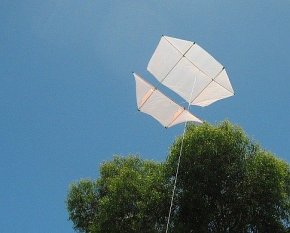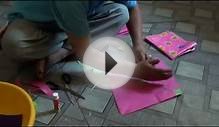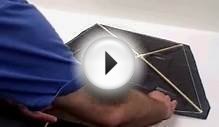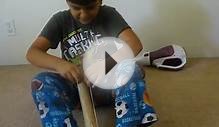
Why build from kite plans? Well, if you've made a few kites before, it's just a bit quicker and more convenient than wading through a long list of step-by-step instructions.
1-Skewer Diamond soarsThere's another plus to the plans-only approach. It's easier to substitute your own different materials or way of doing things, as you see fit. For example, you might use rip-stop nylon instead of plastic, or artificial materials instead of wooden doweling for spars.
Just to give you a sense of the variety of designs here...
Over there in the photo is the dinky little 1-Skewer Diamond. A reliable, easy to make little flyer. You can knock one of these up in minutes.
Further down this page is the Dowel Dopero. With an upper and lower sail plus twin keels and a 4-point bridle, this design takes a lot more patience to complete. But in return, you have an attractive aircraft that likes to wander around directly overhead, no matter how much line you let out! In the right weather, of course.
Kite Plans Table
The links in the table below take you to plans and tips for the 1-Skewer, 2-Skewer and Dowel version of each kite type. Put one together, then go out and fly it really high! The bridle for each kite is made from the same line you intend to fly it on.
Talking about line... If you're building from the Dowel kite plans, you'll need at least 30 pound flying line. Either Dacron or Nylon is suitable...
The Stake Line Winder from Amazon will do the job nicely. The 2-Skewer kites will also do OK with this line.Eventually, you might want to find somewhat lighter line for the 1-Skewer designs, since they struggle a bit if you have too much line out. I've tried polyester sewing thread, and it seems strong enough for these quite small kites!
Note: MBK Skewer Kites are made from thin 12" bamboo skewers, which come in packs of 100. The Metric size is 300mm long x 3mm thick. Sometimes the thickness is just 2.5mm, which works better for the 1-Skewer designs.
Between these kite plans and the list of hints for each one, 90% of the should be covered. If you're a 'plan builder' then the remaining 10% shouldn't worry you!
Here's some tips for finding the if you need to do that for any of these designs.
I've used various kites from these 3 series to illustrate some points about . Have a look if you're interested in this aspect of single-line kiting.
New to this site? OK, let me explain about '1-Skewer', '2-Skewer' and 'Dowel' designs. These simply refer to the basic building block of the kite...
Except for the Delta, 1-skewer designs are no wider than the length of a single 30cm (12") bamboo skewer.
Similarly, 2-skewer designs are mainly constructed with 2 skewers joined end-to-end. Except for the Delta, these designs are never more than 2 skewers wide from tip to tip.
All the Dowel designs except the Delta are 1.2 meters (4 feet) from tip to tip. Also, the Box designs are 1.2 meters in length.
 Dowel Dopero poses near leafy branches
Dowel Dopero poses near leafy branches
Overall Goals
My ultimate goal is to have a large collection of kite plans and instructions that have been refined and standardized through lots of building and flying! Small design changes might creep in too, as I experiment and improve the flying characteristics of these so you have a better chance of success.
Finally, the kite drawings here are not intended for just printing off and enlarging. The result would be stretched a little in the horizontal or vertical direction. However, if you went ahead and built a kite from such a plan, I'm sure it would fly! Nothing a bit more tail and/or dihedral wouldn't fix, don't you think?
There's our Dowel Rokkaku kite in flight, in the video below. This design is also a great thermal soarer, like the Dopero.
- This VPK (Video Platform Kite) is, I suspect, a bit of a giggle now, to some who visit here or subscribe to the newsletter. I've been trotting out rather minimal amounts of information about the proje…
YOU MIGHT ALSO LIKE










